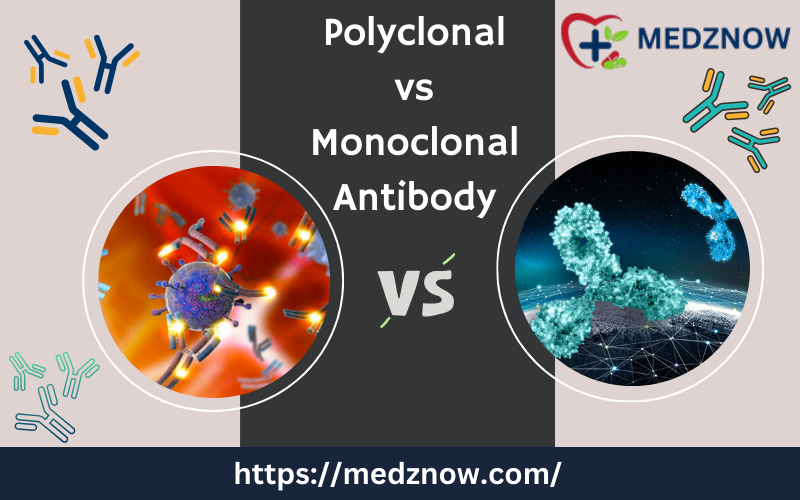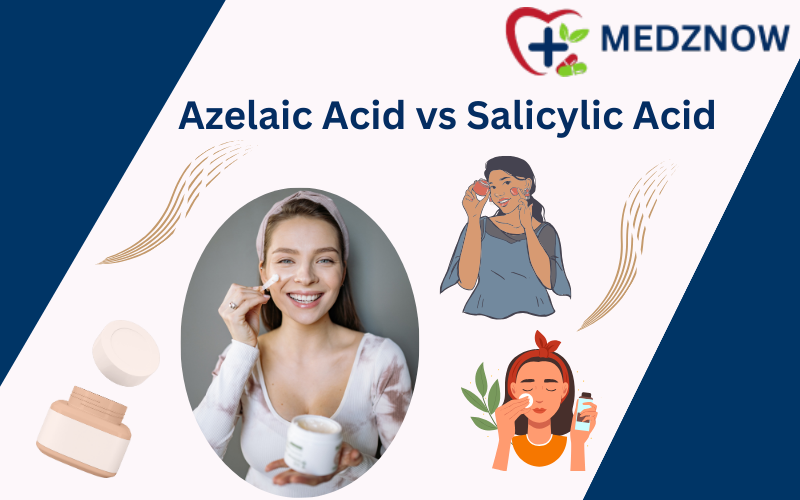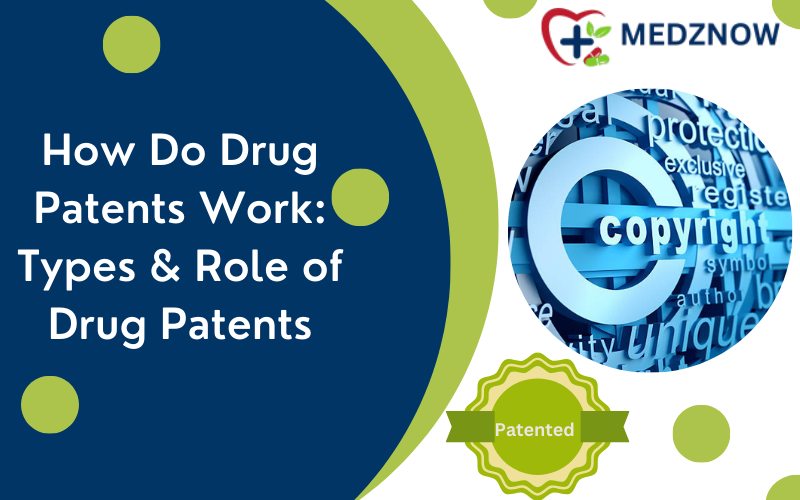Antibodies are the large Y-shaped proteins that protect the body from unwanted substances. These unwanted substances are usually in the form of bacteria, viruses, etc. The other name for antibodies is immunoglobulin. The structure of an antibody is a Y-shaped molecule, which consists of two light and two heavy polypeptide chains. The heavy chain contains 220 amino acids and the light chain 440 amino acids. These chains are bounded in the V-region and lie at the tip of the arm of Y, which are called antigen binding sites. These binding sites are useful in medical sciences and life sciences. Antibody is classified into two types: Polyclonal and Monoclonal. Both antibodies play an important role in the treatment, diagnostic tests, and immune system of the body. In this, article, we’ll discuss the difference between polyclonal vs monoclonal antibody on the basis of uses, working, and side effects.
Brief Overview of Polyclonal Antibody
Antibodies that are made up of different immune cells are called polyclonal antibodies. They are commonly used in the treatment of sheep, rabbits, or guinea pigs. These antibodies are considered as an antiserum, which consists of different B cells in the body.
Polyclonal antibodies involve several steps:
- Monitoring of post-immunization: Monitoring animals is to observe possible side effects of polyclonal antibodies. An extracted antiserum is scanned by antibody conjugation with a detection molecule.
- Antigen Preparation: The results of the process of polyclonal antibodies determine the quality and quantity of an antigen.
- Host Selection: The required amount of polyclonal antibodies and phylogenetic relationship between host and animal identifies the selection of an animal.
- Immunization: Antiserum injections are given to animals to treat their cancer cells.
Brief Overview of Monoclonal Antibody
Monoclonal antibodies are antibodies that treat many diseases. These diseases include various types of cancer in the human body. Monoclonal antibodies specifically target a cancer cell in the body. Researchers found the right antigen to attack cancer cells.
Monoclonal antibodies are made up of different methods. These are as follows:
- Humanized: In this way, the small parts of mouse proteins are attached to human proteins. The treatment names end with the ‘-zumab’ letters at the end of each name.
- Human: The monoclonal antibodies are fully human proteins. Its treatment names end with ‘-umab’.
- Murine: The monoclonal antibodies are made from mouse proteins. Its treatment names end with ‘-omab’.
- Chimeric: The monoclonal antibodies are a combination of part human and part mouse. Its treatment names end with ‘-ximab’.
In this blog, we will compare Polyclonal and Monoclonal antibodies.
Comparison Between Polyclonal and Monoclonal Antibodies
Quantity
a. Polyclonal Antibody:
Polyclonal antibody requires large amounts of antibody in the body.
b. Monoclonal Antibody:
Monoclonal antibody requires limited or small amounts of antibodies in the human body.
Uses
a. Polyclonal Antibody:
Polyclonal antibodies consist of several uses. These include the following:
- Detection of conformational or glycosylation changes.
- Detection of targeted genetic polymorphisms.
- Detection of targeted solutions with variable pH values and salt concentration.
- Detection of low-level particular antigens.
b. Monoclonal Antibody:
The several uses of monoclonal antibodies are as follows:
- Detecting molecular conformational and phosphorylation state changes, targeted X-ray crystallography, specific antigens, etc.
- Measuring the quantity of protein.
- Creating consistent results between two or more than two experiments.
- Creation of animal models.
- Immunotherapy
Brand names
a. Polyclonal Antibody:
The brand names of polyclonal antibodies are Atgam, Antithymycocite, and ATG equine.
b. Monoclonal Antibody:
The brand names of monoclonal antibodies are Campath, Hybri-ceaker, Praluent, and Lemtrada.
Working
a. Polyclonal Antibody:
The work of polyclonal antibodies is to prevent the rejection of kidney transplant and aplastic anemia in the patient’s body. Aplastic anemia is uncomfortable for transplantation of bone marrow. It is a rare and serious side effect when blood cells are not working properly in the body.
Different B-cell lineages are secreted by polyclonal antibodies in the body. These antibodies collect immunoglobulin, which treats bacteria and viruses.
b. Monoclonal Antibody:
The work of monoclonal antibodies is to deliver chemotherapy and radiation treatment, blocking the growth of cancer cells and cells of the immune system, preventing the growth of blood vessels, and targeting cancer cells in the human body.
Side Effects
a. Polyclonal Antibody:
The side effects of polyclonal antibodies are:
- Chest pain
- Back pain
- Rash
- Itching
- Hives
- Dizziness
- Leukopenia
- Thrombocytopenia
- Joint pain
- Tachycardia
b. Monoclonal Antibody:
- Heart attacks
- Lung disease
- Mouth and skin sores
- Low blood pressure
- Fever
- Nausea
- Vomiting
- Headache
Cost
a. Polyclonal Antibody:
Polyclonal antibodies are generally cost-effective than monoclonal antibodies.
b. Monoclonal Antibody:
Monoclonal antibodies are more expensive than polyclonal antibodies.
Treatment
a. Polyclonal Antibody:
Polyclonal antibodies lack specificity and high-degree of cross-reactivity than monoclonal antibodies. However, they are less suitable for treating cancer cells in patients.
b. Monoclonal Antibody:
The ability of monoclonal antibodies is to find and target cancer cells in the human body. These antibodies are used as medicine to fight against cancer cells, rheumatoid arthritis, asthma, and other diseases.
Diagnostic Studies
a. Polyclonal Antibody:
The ability of polyclonal antibodies is to recognize different epitopes of a target molecule or cell for diagnostic studies. These antibodies are used as secondary antibodies in immunoassays, which include western blotting, flow cytometry, immunohistochemistry, microarray assays, and Enzyme-Linked Immunosorbent Assays (ELISA).
The binding of different epitopes and signal amplification is the role of polyclonal antibodies to detect antigens better in the human body.
b. Monoclonal Antibody:
The ability of monoclonal antibodies is to specifically bind to a single epitope of an antigen. These antibodies work as a primary antibody in immunoassays. When these antibodies combine to each other, they capture multiple epitopes and expand their specificity.
Advantages
a. Polyclonal Antibody
- High sensitivity to detect low-quantity proteins.
- Low-cost and short-time production
- High-affinity
b. Monoclonal Antibody
- Low background noise and cross-reactivity
- High homogeneity
- Produces large amounts of different antibodies
Conclusion
This blog explains the comparison between polyclonal and monoclonal antibodies. Both these antibodies are used for the treatment of cancer cells in different ways. They prevent cancer from developing in the human body.













